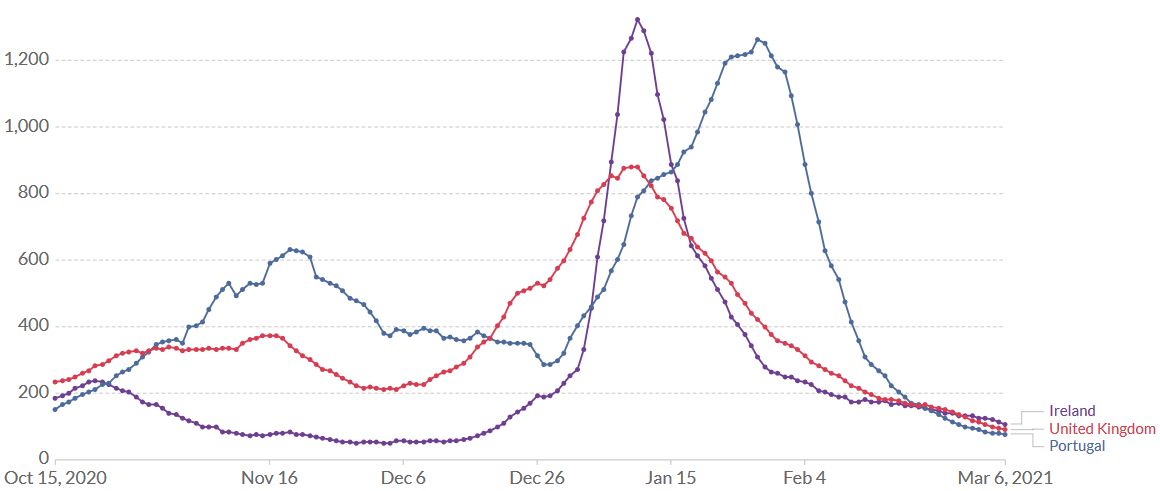Variants: Weekly Summary 27 March
<<< Chapter Variants
Paris is burning
In Île-de-France (Greater Paris region, 12 million people), the 7-day rolling incidence per 100.000 was approaching 600 this week (Figure 1). Hospital services, both intensive and non-intensive COVID units, are saturated although we are seeing only the beginning of the third pandemic wave. The current outbreak is boosted by the ‘English’ B.1.1.7 variant which is also highly transmissible among children (Figure 2).

Figure 1. 7-day rolling incidence per 100.000 people in the 13 French régions (Évolution des taux d’incidence COVID-19 par semaine glissante par région (France)). Source and copyright: Germain Forestier: 26 March, https://bit.ly/39fhva7.

Figure 2. 7-day rolling incidence per 100.000 people stratified by age class in Seine-Saint-Denis, France. (Évolution des taux d’incidence COVID-19 par classe d’âges par semaine glissante (Seine-Saint-Denis)). Source and copyright: Germain Forestier: 22 March, https://bit.ly/3rjsvJF.
The French government has favored the surge of new SARS-CoV-2 infections by keeping schools open and postponing a hard lockdown. It is astonishing to witness that even in an era of global real-time information people continue to be unable to look beyond national borders. Why should France have been spared the fate of the UK, Ireland and Portugal where the ‘B.1.1.7 pandemic in a pandemic’ exploded at the beginning of the year (Figure 3)?
The only good news is that lockdowns are efficient against B.1.1.7. So, Emmanuel, please listen: you cannot live with the virus (vivre avec le virus), you can only fight it. Vaccines will come too late to have a significant impact on the imminent meltdown of France’s healthcare system. Close your schools now and order a hard lockdown! The situation in your country may soon become ‘bergamesques’.

Figure 3. United Kingdom, Ireland, Portugal, 6 March. Lockdowns are efficient against B.1.1.7. After a peak of the rolling 7-day average on 10 January (UK, Ireland) and 28 January (Portugal), the number of daily new confirmed SARS-CoV-2 cases decreased rapidly. Source: Our World in Data – Johns Hopkins University CSSE COVID-19 Data.
Important publications of the week
Immune escape
Edara VV, Norwood C, Floyd K, et al. Infection and vaccine-induced antibody binding and neutralization of the B.1.351 SARS-CoV-2 variant. Cell Host Microbe 2021, published 20 March. Full text: https://doi.org/10.1016/j.chom.2021.03.009
Despite reduced antibody titers against the B.1.351 variant (first detected in South Africa), sera from infected and vaccinated individuals containing polyclonal antibodies to the spike protein could still neutralize SARS-CoV-2 B.1.351. The authors conclude that protective humoral immunity may be retained against this variant.
Hoffmann M, Arora P, Groß R, et al. SARS-CoV-2 variants B.1.351 and P.1 escape from neutralizing antibodies. Cell 2021, accepted 16 March. Full-text: https://doi.org/10.1016/j.cell.2021.03.036
The authors show that entry of all variants into human cells is susceptible to blockade by the entry inhibitors soluble ACE2, Camostat, EK-1 and EK-1-C4. In contrast, entry of B.1.351 and P.1 was partially (casirivimab) or fully (bamlanivimab) resistant to monoclonal antibodies. Moreover, entry of these variants was less efficiently inhibited by plasma from convalescent COVID-19 patients and sera from individuals vaccinated with the Pfizer-BioNTech vaccine.
McCormick KD, Jacobs JL, Mellors JW. The emerging plasticity of SARS-CoV-2. Science 2021, published 26 March. Full text: https://doi.org/10.1126/science.abg4493
+
Abdool Karim SS, de Oliveira T. New SARS-CoV-2 Variants — Clinical, Public Health, and Vaccine Implications. N Engl J Med 2021, published 24 March. Full text: https://doi.org/10.1056/NEJMc2100362
Excellent summaries of this Variants chapter with some interesting additions.
Surveillance
Abbasi J. How the US Failed to Prioritize SARS-CoV-2 Variant Surveillance. JAMA. 2021 Mar 24. PubMed: https://pubmed.gov/33760030. Full-text: https://doi.org/10.1001/jama.2021.3368
Until late last fall, public health departments had no federal mandate or additional funding to sequence samples, although new variants were an inevitability.
Peer-reviewed former preprints
Volz E, Mishra S, Chand M, et al. Assessing transmissibility of SARS-CoV-2 lineage B.1.1.7 in England. Nature (2021). Full text: https://doi.org/10.1038/s41586-021-03470-x
The preprint we presented on 13 January now published in Nature: the authors describe the new SARS-CoV-2 lineage B.1.1.7 (AKA VOC 202012/01) which originated in England, late Summer to early Autumn 2020. The data indicate a transient shift in the age composition of reported cases, with a larger share of under-20-year-olds among B.1.1.7 cases than among historical cases. B.1.1.7 has a substantial transmission advantage with a 50% to 100% higher reproduction number.
Previous Weekly Summaries
Please find the previous summaries at
- 20 March: https://covidreference.com/variants-20-march
- 6 March: https://covidreference.com/variants-6-march
- 27 February: https://covidreference.com/variants-27-february
- 20 February: https://covidreference.com/variants-20-february
- 13 February: https://covidreference.com/variants-13-february
- 6 February: https://covidreference.com/variants-6-february
- 31 January: https://covidreference.com/variants-31-january
